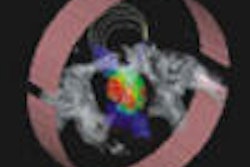Patients with previous myocardial infarction and severe left ventricular dysfunction (with left ventricular ejection fractions below 35%) have a poor prognosis for survival. As a result, establishing viable myocardial tissue is a crucial factor when considering these patients for coronary artery bypass grafting.
A research team from the Institute of Clinical Physiology of the National Research Council in Pisa, Italy, recently explored the capability of semiquantitative rest and postnitrate Tc-99m tetrofosmin SPECT compared with contrast-enhanced MRI (ceMRI) in detecting myocardial viability.
"Despite the demonstration of the clinical utility of imaging with Tc-99m-labeled compounds, their extensive application when the issue is viability continues to encounter practical resistance, and often other radioisotopes or scintigraphic protocols are preferred," they wrote in the Journal of Nuclear Medicine (August 2005, Vol. 46:8, pp. 1285-1293).
The researchers noted that Tc-99m-labeled compounds are widely used in nuclear cardiology in Europe, and that the use of nitrates before radiotracer injection seems to consistently increase regional differences in uptake, improving the ability to identify hibernating myocardium.
The team studied 21 patients, 19 males and two females with an average age of 60 years, who had previous myocardial infarction and severe left ventricular dysfunction, determined by ceMRI, with an ejection fraction of 29% ± 6%. All the patients had, in random order and within 15 days, a physical examination, baseline electrocardiogram and echocardiogram, ceMRI, Tc-99m tetrofosmin gated SPECT before and after nitrate administration, and coronary angiography, according to the researchers.
The rest and postnitrate SPECT studies were conducted in a single day. Between 296-370 MBq of Tc-99m tetrofosmin was administered intravenously while the patients were at rest. They then ate a fatty meal 15 minutes later to accelerate the tracer's hepatopathobiliary clearance. A dual-head camera (ECam, Siemens Medical Solutions, Erlangen, Germany) was used to perform the SPECT studies.
The group used a 64 x 64 matrix, 32 projections, 40-sec projections, 8 frames/cycle protocol in association with a 15% window centered on the 140-keV photopeak of Tc-99m. The images were reconstructed using filtered back projection without attenuation or scatter.
After the baseline study was completed, the patients were administered a nitrate infusion, 740-888 MBq of Tc-99m tetrofosmin, and the SPECT imaging protocol was conducted again. Software (E.Soft, Siemens Medical Solutions) was then used for measuring regional myocardial wall motion and wall thickening from the 3D gated myocardial perfusion SPECT images. In addition, regional perfusion was assessed by quantitative perfusion SPECT.
The ceMRI exams were performed on a 1.5-tesla whole-body scanner (CVi, GE Healthcare, Chalfont St. Giles, U.K.) with a high-performance gradient, multichannel receiver, and four-element cardiac phased-array surface coil for signal reception. Regional and contractile function was evaluated with breath-hold segmented gradient-echo fast imaging, using steady-state acquisition and an electrocardiographically triggered sequence.
The researchers stated that the delayed postcontrast images were acquired in the short axis of the left ventricle 20 minutes after bolus injection of 0.2 mmol/kg of gadolinium-diethylenetriaminepentaacetic acid (Gd-DTPA) in end diastole for evaluating myocardial distribution of hyperenhancement. Nonviable tissue was identified on images taken 20 minutes after the administration of contrast.
The patient population also underwent standard coronary angiography and single-plane contrast ventriculography in multiple views within two weeks of the scintigraphic studies. The angiograms were evaluated qualitatively and quantitatively by two physicians who were unaware of the protocol study, according to the authors.
The team compared the SPECT and ceMRI data with one another. They wrote that the regional Tc-99m tetrofosmin percentage uptake was higher in ceMRI-viable segments than in nonviable segments at rest and increased significantly after nitrates in ceMRI-viable areas, whereas it did not in ceMRI-nonviable areas.
They also observed that the resting Tc-99m tetrofosmin predicted myocardial viability in 88 of 102 segments for an 86% sensitivity and scarring in 53 of 94 segments for a 56% specificity, with a 71% global accuracy. In contrast, the postnitrate Tc-99m tetrofosmin scans demonstrated an 89% sensitivity, 78% specificity, and 84% global accuracy.
"In our study, the postnitrate results appeared to be closely correlated with ceMRI data and likely with ceMRI diagnostic previously published implications," the authors wrote.
The researchers noted that their study size was limited to 21 patients, and that a lack of follow-up prevented the investigation of correlations between myocardial viability assessed by Tc-99m tetrofosmin and functional recovery after revascularization. However, they believe that use of the SPECT radiotracer with their protocol shows promise.
"Our results confirm and expand previous observations demonstrating that postnitrate Tc-99m tetrofosmin imaging accurately depicts myocardial viability when it is also investigated using an independent marker of myocardial fibrosis with high spatial resolution, such as ceMRI," they wrote.
By Jonathan S. Batchelor
AuntMinnie.com staff writer
September 28, 2005
Related Reading
New EU rules threaten MRI research, use - experts, September 21, 2005
Can SPECT/CT revitalize nuclear medicine? July 7, 2005
SPECT reveals sharply higher cardiac risk within metabolic syndrome, April 22, 2005
SPECT/CT developing role in coronary artery disease assessment, March 22, 2005
3-tesla scanning fails to improve coronary MRA's accuracy, March 11, 2005
Copyright © 2005 AuntMinnie.com




















